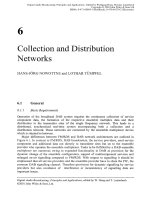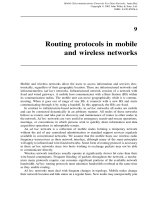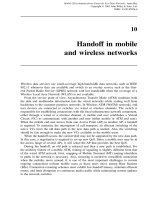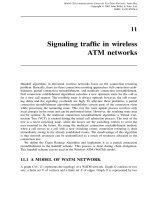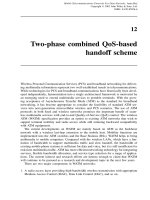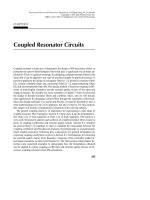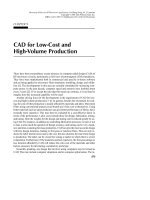Tài liệu DAV Nguyên tắc và các ứng dụng P12 pptx
Bạn đang xem bản rút gọn của tài liệu. Xem và tải ngay bản đầy đủ của tài liệu tại đây (149.02 KB, 20 trang )
12
Two-phase combined QoS-based
handoff scheme
Wireless Personal Communication Services (PCS) and broadband networking for deliver-
ing multimedia information represent two well-established trends in telecommunications.
While technologies for PCS and broadband communications have historically been devel-
oped independently, harmonization into a single architectural framework is motivated by
an emerging need to extend multimedia services to portable terminals. With the grow-
ing acceptance of Asynchronous Transfer Mode (ATM) as the standard for broadband
networking, it has become appropriate to consider the feasibility of standard ATM ser-
vices into next-generation microcellular wireless and PCS scenarios. The use of ATM
protocols in both fixed and wireless networks promises the important benefit of seam-
less multimedia services with end-to-end Quality-of-Service (QoS) control. The wireless
ATM (WATM) specification provides an option to existing ATM networks that wish to
support terminal mobility and radio access while still retaining backward compatibility
with ATM equipments.
The current developments on WATM are mainly based on ATM as the backbone
network with a wireless last-hop extension to the mobile host. Mobility functions are
implemented into the ATM switches and the Base Stations (BSs). WATM helps to bring
multimedia to mobile computers. Compared with the wireless LANs, which have a lim-
itation of bandwidth to support multimedia traffic and slow handoff, the bandwidth of
existing mobile phone systems is sufficient for data and voice, but it is still insufficient for
real-time multimedia traffic. ATM has more efficient networking technology for integrating
services, flexible bandwidth allocation, and service type selection for a range of applica-
tions. The current interest and research efforts are intense enough to claim that WATM
will continue to be pursued as a research and development topic in the next few years.
There are two major components in WATM networks:
1. A radio access layer providing high-bandwidth wireless transmission with appropriate
Medium Access Control (MAC), Data Link Control (DLC), and so on.
Mobile Telecommunications Protocols For Data Networks. Anna Ha
´
c
Copyright
2003 John Wiley & Sons, Ltd.
ISBN: 0-470-85056-6
214
TWO-PHASE COMBINED QoS-BASED HANDOFF SCHEME
2. A mobile ATM network for interconnection of BSs [Access Points (APs)] with appro-
priate support of mobility related functions, such as handoff and location management.
We focus on the mobile ATM handoff control required to support Mobile Terminal
(MT) migration from one WATM microcell BS to another. The handoff function should
ensure that the ongoing connection is rerouted to another AP in a seamless manner. The
design goal of the handoff in WATM is to prevent service disruption and degradation
during and after the handoff process.
To support wireless users in an ATM network, the main challenges are due to the
mobility of the wireless users. If a wireless user moves while communicating with another
user or a server in the network, the network may need to transfer the radio link of the user
between radio APs in order to provide seamless connectivity to the user. The transfer of
a user’s radio link is referred to as handoff. During a handoff event, the user’s existing
connection may need to be rerouted in order to meet delay, QoS or cost criteria, or
simply to maintain connectivity between two users, or between a server and wireless
users. Rerouting is critical to wireless networks that need to maintain connectivity to a
wireless user through multiple, geographically dispersed radio APs. Rerouting must be
done quickly to maintain connectivity to the network during a handoff event. In addition,
the resulting routes must be optimum. A two-phase interswitch handoff scheme meets the
requirement of the rerouting. In the first phase, connections are rapidly rerouted and in
the second phase a route optimization procedure is executed. For the two-phase handoff
scheme, the first phase is simply implemented by path extension and the second phase is
implemented by partial path reestablishment.
We describe the QoS-based rerouting algorithm that is designed to implement two-
phase interswitch handoff scheme for WATM networks. We use path extension for each
interswitch handoff, and invoke path optimization when the handoff path exceeds the
delay constraint or maximum path extension hops constraint. We study three types of
path optimization schemes: combined QoS-based, delay-based and hop-based path rerout-
ing schemes.
We use QoS combined path optimization scheme for WATM network. We focus on the
problems related to the support of mobility in the WATM network. This scheme determines
when to trigger path optimization for the two-phase handoff and how to minimize the
service disruption during path optimization.
12.1 WIRELESS ATM ARCHITECTURE
A WATM network is intended to support integrated broadband services to MTs through an
ATM User Network Interface (UNI). Figure 12.1 shows a network diagram that illustrates
various network entities and the functions that are required to support mobility in such
an ATM network.
In this architecture, the MT is an ATM end system that can support multimedia appli-
cations. The wireless link between the MT and BS provides the desired ATM transport
services to the MT. A mobility-enhanced signaling protocol based on the ITU recommen-
dation Q.2931 is used by the MT, BS, and Mobility Support Switches (MSS) to support
handoff-related functions.
WIRELESS ATM ARCHITECTURE
215
Wireless control
Wireless control
Wireless control
Mobile
support
ATM switch
Mobile
support
ATM switch
LS
PNNI (Q.2931 +)
LS
PVC
ATM UNI
ATM UNI
MT
MT
Q.2931 +
Q.2931 +
BS1
BS2
ATM switch
LS
LS
Regular
ATM switch
Switch host
Q.2931 +
Figure 12.1 Network entities and functions for mobility support in ATM network.
There are two types of interfaces in ATM: the UNI and Network-to-Network Interface
(NNI). Both interfaces can be private or public depending on the network. In the location
management scheme that is proposed as Location Server (LS), a database is required to
register the location of the MT.
The ATM Forum designed the WATM specifications, which are compatible with standard
ATM protocols by providing ATM-based radio access as well as extensions for mobility sup-
port within an ATM network. The wireline and wireless ATM protocol stacks are shown in
Figure 12.2, in which the shaded areas represent new sublayers added for wireless support.
At the bottom of the protocol stack is the physical layer. In order to support a
wide range of multimedia applications, the WATM physical layer should provide rea-
sonably high data rates. A MAC protocol in WATM is needed to meet the following
requirements:
• It should be able to work with the upper-layer protocol seamlessly.
• The MAC layer should be designed to use bandwidth efficiently to accommodate a
reasonably large number of users.
• The MAC protocol should guarantee a certain QoS to the user for various services,
such as Constant Bit Rate (CBR), Variable Bit Rate (VBR), Available Bit Rate (ABR),
and Unspecified Bit Rate (UBR).
216
TWO-PHASE COMBINED QoS-BASED HANDOFF SCHEME
Wireline ATM protocol stack Wireless ATM protocol stack
User plane
(transport)
Control plane
(signaling)
ATM adaptation layer
ATM layer
Physical layer
User
plane
Control plane
ATM adaptation layer
ATM layer
Data link control
Medium access control
Wireless physical layer
Radio
access
control
Mobility control
Figure 12.2 Wireline and wireless ATM protocol stacks.
The DLC protocol can provide error control by retransmitting damaged or lost frames.
To prevent a fast sender from overrunning a slow receiver, the data link protocol can also
provide flow control. The sliding window mechanism is widely used to integrate error
control and flow control.
The purpose of the ATM Application layer is to convert the data from a higher layer
(e.g., the application layer) into a format that is suitable for transmission over ATM cells.
In other words, the ATM Adaptation-Layer (AAL) protocol provides an interface between
the application layer and the ATM network layer. The AAL protocol is available to adapt
the different applications without sacrificing its inherent advantages – low delay and fast
transport. The AAL is broken down into two sublayers: the Convergence Sublayer (CS)
that performs service-dependent functions and the Segmentation and Reassembly (SAR)
sublayer that performs segmentation and reassembly. In order to define the functions of
the CS, we can divide the services into four classes as shown in Table 12.1.
On the basis of the different types of services as shown in Table 12.1, the adaptation-
layer protocol has been classified into five types. AAL1 (voice) emulates a synchronous,
CBR connection. AAL2 (video) is suitable for the traffic that has a bit rate that varies
in time and requires delay bounds such as compressed video. AAL3 and AAL4 as well
as AAL5 (packet transfer) provide frame segmentation and reassembly functions and
are suited for variable traffic without delay requirement. The ATM Forum agreed that
AAL1 will support CBR service and AAL5 will support all other services. By far, the
AAL5 is the most important of the AALs. AAL5 connections allow ATM networks to
interface with the Internet’s transport protocol, TCP/IP, by packaging the IP packets
into ATM cells.
MOBILITY SUPPORT IN WIRELESS ATM
217
Table 12.1 Types of services and attributes
Service class Attributes
A Connection oriented, CBR, needs to transmit timing information over
the ATM cells, e.g., circuit emulation.
B Connection oriented, VBR-RT, needs to transmit timing information
over the ATM cells, e.g., multimedia service with VBR video
and audio.
C Connection oriented, VBR-NRT, ABR, UBR, does not need to
transmit timing information over the ATM cells, e.g., traditional
data traffic such as X.25.
D Connectionless, VBR-NRT, ABR, UBR, does not need to transmit
timing information over the ATM cells, e.g., e-mail service.
The mobility control sublayer immediately above the MAC layer performs control
functions related to the physical radio channel control and metasignaling between the MT
and BSs (e.g., terminal initialization, handoff, and power control).
12.2 MOBILITY SUPPORT IN WIRELESS ATM
A key feature of any wireless network is the capability to support handoff. Handoff is an
action of switching a call in progress in order to maintain continuity and the required QoS
of the call when a MT moves from one cell to another. In a mobile ATM network, an MT
can have several active links with different QoS requirements. These Virtual Channels
(VCs) with different QoS introduce challenges to the handoff protocol. In general, the
handoff with multirate ATM connections must be supported with low cell loss, latency,
and control overhead. The QoS constraints for each individual connection should be
maintained during the MT migration.
There are several types of handoff. We can classify the types of handoff on the basis of
the number of active connections and the direction of the handoff signaling. We describe
these types of handoff as follows:
On the basis of the number of active connections
The handoffs can be classified on the basis of the number of connections that an MT
maintains during the handoff procedure. There are two types of handoffs based on this
classification: hard handoff and soft handoff.
In hard handoff, the MT switches the communication from the old link to the new
link. Thus, there is only one active connection from the MT at any time. There is a short
interruption in the transmission. This interruption should be minimized in order to make
the handoff seamless.
218
TWO-PHASE COMBINED QoS-BASED HANDOFF SCHEME
In soft handoff, the MT is connected simultaneously to two APs. As it moves from
one cell to another, it ‘softly’ switches from one BS to another. When connected to two
BSs, the network combines information received from two different routes to obtain a
better quality. This is commonly referred to as macrodiversity.
On the basis of the direction of the handoff signaling
Another way of classifying the handoff is on the basis of the direction of the handoff
signaling. There are two types of handoffs based on this classification: forward handoff
and backward handoff.
In forward handoff, after the MT decides the cell to which it will make a handoff, it
contacts the BS controlling the cell. The new BS initiates the handoff signaling to link
the MT from the old BS. This is especially useful if the MT suddenly loses contact with
the current BS.
In backward handoff, after the MT decides the cell to which it attempts to make a
handoff, it contacts the current BS, which initiates the signaling to handoff to the new BS.
There are five types of handoff schemes: handoff using full reestablishment, handoff
using multicasting, handoff using connection extension, handoff using partial reestablish-
ment, and handoff using two-phase protocol.
Handoff using full reestablishment
In a connection-oriented wireless environment, virtual circuits are established from the
source to the destination. The data follows the path that has been set up, and an in-
order delivery is guaranteed. If a handoff is to occur, the old virtual connection is torn
down and an entirely new virtual circuit is set up from the current source to the current
destination. Since both ends are explicitly involved, this handoff scheme is not transparent.
Severe traffic interruptions are experienced and hence this scheme is not recommended.
Figure 12.3 shows the handoff using full reestablishment.
S
Base
station
ATM switch
Base
station
Base
station
D
D
S − source
D − destination
Path before handoff
Path after handoff
Figure 12.3 Handoff using full reestablishment.
MOBILITY SUPPORT IN WIRELESS ATM
219
Handoff using multicasting
Multicasting is used to support handoffs in both the connection oriented and connectionless
scenarios. In the case of WATM environment, multicasting is used to establish links to
all BSs that are neighboring the BS that is currently controlling a MT. Subsequently, in
whichever direction the MT moves, a handoff path has already been established. Also,
since the data is being multicast, it continues to flow without any interruption. This scheme
ensures a lossless and seamless handoff. However, since data is being multicast to the
entire set of nodes, most of which is unused, bandwidth is being utilized very inefficiently.
Also, if an MT is at the edge of two cells, it is very likely that it might get two copies
of the data packets. This leads to other complications like BS synchronization. Thus, this
scheme is not recommended. Figure 12.4 shows the handoff using multicasting.
Handoff using connection extension
The basic idea of this scheme is that the local paths are more affordable than the global
paths. When an MT migrates from one BS to another, the old BS extends the connection to
the new BS. The obvious disadvantage of this method is that the new path to the MT is not
an optimal path. Figure 12.5 shows the handoff using the connection extension scheme.
Handoff using partial reestablishment
This scheme is certainly better than reestablishing a new connection from the source to
the destination or extending an existing connection to the new BS. This scheme uses the
concept of a Crossover Switch (COS). The new BS does a partial reestablishment of the
S
Base
station
ATM switch
Base
station
Base
station
Base
station
Base
station
D
S − source
D − destination
Multicast path
Path before handoff
Figure 12.4 Handoff using multicasting.
220
TWO-PHASE COMBINED QoS-BASED HANDOFF SCHEME
S
Base
station
ATM switch
Base
station
Base
station
D
D
S − source
D − destination
Path before handoff
Path after handoff
Figure 12.5 Handoff using connection extension.
S
Base
station
ATM switch
Base
station
Base
station
D
D
S − source
D − destination
Path before handoff
Path after handoff
Figure 12.6 Handoff using partial reestablishment.
connection, by opening a connection to the COS. This way, it attempts to reuse as much
of the existing connection as possible. The old partial path is then torn down and the
resources are released. Buffering is done at the COS, which ensures in-order delivery of
the cells. Figure 12.6 shows the handoff using partial reestablishment.
Handoff using two-phase protocol
A two-phase handoff protocol has been proposed by Wong and Salah, which combined
the connection extension and partial reestablishment schemes.
The two-phase handoff protocol consists of two phases, that is, path extension and path
optimization. Path extension is performed for each interswitch handoff. Path optimization
is activated when the delay constraint or other cost is violated. Figure 12.7 shows the


